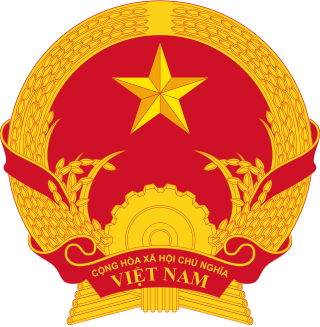
The politics of Vietnam is dominated by a single party under an authoritarian system, the Communist Party of Vietnam (CPV). The President of Vietnam is the head of state, and the Prime Minister of Vietnam is the head of government, both of these are separate from the General Secretary of the Communist Party of Vietnam who leads the CPV and is head of the Politburo and the Central Military Commission, thus the General Secretary is the de facto supreme leader of Vietnam. Executive power is exercised by the government and the President of Vietnam. Legislative power is vested in the National Assembly of Vietnam. The Judiciary is independent of the executive. The parliament adopted the current Constitution of Vietnam, its fifth, on 28 November 2013.

The People's Army of Vietnam (PAVN), officially the Vietnam People's Army, also recognized as the Vietnamese Army or the People's Army, is the national military force of the Socialist Republic of Vietnam and the armed wing of the ruling Communist Party of Vietnam (CPV). The PAVN is a part of the Vietnam People's Armed Forces and includes: Ground Force, Navy, Air Force, Border Guard and Coast Guard. Vietnam does not have a separate Ground Force or Army service. All ground troops, army corps, military districts and special forces belong to the Ministry of National Defence, directly under the command of the CPV Central Military Commission, the Minister of National Defence, and the General Staff of the Vietnam People's Army. The military flag of the PAVN is the National flag of the Socialist Republic of Vietnam defaced with the motto Quyết thắng added in yellow at the top left.

The Lao People's Revolutionary Party (LPRP) is the founding and sole ruling party of the Lao People's Democratic Republic. The party's monopoly on state power is guaranteed by Article 3 of the Constitution of Laos, and it maintains a unitary state with centralised control over the economy and military.
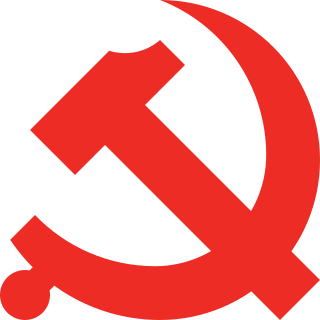
The Central Military Commission (CMC) is the highest national defense organization in the People's Republic of China, which heads the People's Liberation Army (PLA), the People's Armed Police (PAP), and the Militia of China.
A communist state is a form of government that combines the state leadership of a communist party, Marxist–Leninist political philosophy, and an official commitment to the construction of a communist society. Communism in its modern form grew out of the socialist movement in 19th-century Europe and blamed capitalism for societal miseries. In the 20th century, several communist states were established, first in Russia with the Russian Revolution of 1917 and then in portions of Eastern Europe, Asia, and a few other regions after World War II. The institutions of these states were heavily influenced by the writings of Karl Marx, Friedrich Engels, Vladimir Lenin, Joseph Stalin and others. However, the political reforms of Soviet leader Mikhail Gorbachev known as Perestroika and socio-economic difficulties produced the revolutions of 1989, which brought down all the communist states of the Eastern Bloc bar the Soviet Union. The repercussions of the collapse of these states contributed to political transformations in the Soviet Union and Yugoslavia and several other non-European communist states. Presently, there are five communist states in the world: China, Cuba, Laos, North Korea and Vietnam.
A national security council (NSC) is usually an executive branch governmental body responsible for coordinating policy on national security issues and advising chief executives on matters related to national security. An NSC is often headed by a national security advisor and staffed with senior-level officials from military, diplomatic, intelligence, law enforcement and other governmental bodies. The functions and responsibilities of an NSC at the strategic state level are different from those of the United Nations Security Council, which is more of a diplomatic forum.

The Communist Party of Vietnam (CPV), also known as the Vietnamese Communist Party (VCP), is the founding and sole legal party of the Socialist Republic of Vietnam. Founded in 1930 by Hồ Chí Minh, the CPV became the ruling party of North Vietnam in 1954 and then all of Vietnam after the collapse of the South Vietnamese government following the Fall of Saigon in 1975. Although it nominally exists alongside the Vietnamese Fatherland Front, it maintains a unitary government and has centralized control over the state, military, and media. The supremacy of the CPV is guaranteed by Article 4 of the national constitution. The Vietnamese public generally refer to the CPV as simply "the Party" or "our Party".

The prime ministerof Vietnam, is the head of government of Vietnam who presides over the meetings of the Government. The prime minister directs the work of government members, and may propose deputy prime ministers to the National Assembly.

The president of the Socialist Republic of Vietnam is the head of state of Vietnam, elected by the Vietnam National Assembly from delegates of the National Assembly. Since Vietnam is a single-party state, the president is generally considered to hold the second highest position in the political system, formally after the general secretary of the Communist Party of Vietnam. In addition, the president appoints the head of government, the prime minister. As head of state, the President represents Vietnam both domestically and internationally, and maintains the regular and coordinated operation and stability of the national government and safeguards the independence and territorial integrity of the country.
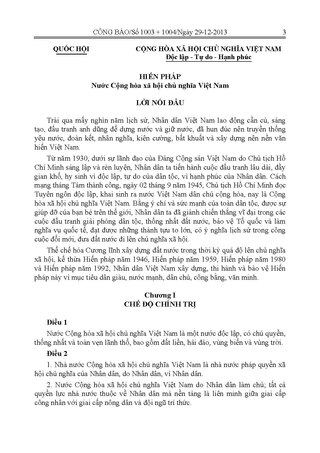
The Vietnamese Constitution or the Constitution of Vietnam, fully the Constitution of the Socialist Republic of Vietnam, is the fundamental and supreme law of the Socialist Republic of Vietnam. The current constitution was adopted on November 28, 2013, by the Thirteenth National Assembly and took effect on January 1, 2014, being the third constitutions adopted by the Vietnamese state since the political reunification of the country in 1976.

The Communist Party of Thailand was a communist party in Thailand active from 1942 until the 1990s.
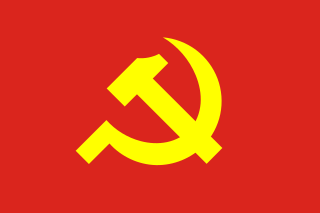
The 10th National Congress of the Communist Party of Vietnam was held in Ba Đình Hall, Hanoi from 18 to 25 April 2006. The congress occurs every five years. 1,176 delegates represented the party's 3 million members. At the 13th plenum of the Central Committee, held before the congress, it was decided that eight members of the Communist Party's 9th Politburo had to retire. While certain segments within and outside the Politburo were skeptical, the decision was implemented. Because of party rules, the congress was not empowered to elect the general secretary, and it held a survey on whom the delegates wanted to be appointed General Secretary. The first plenum of the Central Committee, held in the immediate aftermath of the congress, re-elected Nông Đức Mạnh as general secretary.
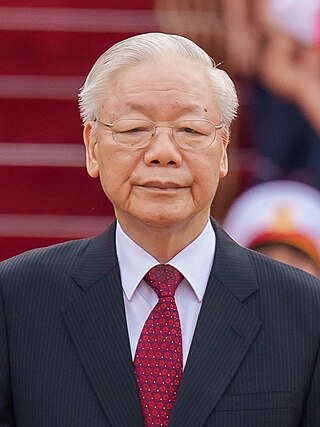
Nguyễn Phú Trọng is a Vietnamese politician who has served as general secretary of the Communist Party of Vietnam since 2011. As the head of the party's Secretariat, Politburo and Central Military Commission, Trọng is Vietnam's paramount leader. He also previously served as president of Vietnam from 2018 to 2021.

The People's Republic of Kampuchea (PRK) was a partially recognised state in Southeast Asia which existed from 1979 to 1989. It was a client state of Vietnam, founded in Cambodia by the Vietnamese-backed Kampuchean United Front for National Salvation, a group of Cambodian communists who were dissatisfied with the Khmer Rouge due to its oppressive rule and defected from it after the overthrow of Democratic Kampuchea, Pol Pot's government. Brought about by an invasion from Vietnam, which routed the Khmer Rouge armies, it had Vietnam and the Soviet Union as its main allies.

The Ministry of Defense was a government ministry in the Soviet Union, which supervised the Soviet Armed Forces. The first Minister of Defense was Nikolai Bulganin, starting 1953.

The Political Bureau (Politburo) of the Central Standing Committee of the Communist Party of Vietnam is the highest body of the Communist Party of Vietnam (CPV) in between gatherings of the National Congress and of the plenary sessions Central Committee. According to Party rules, the Politburo directs the general orientation of the government, and by that, it has dominant power in the politics of Vietnam.
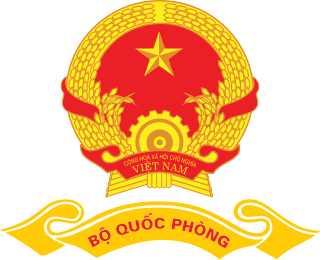
The Ministry of National Defence, alternatively the Ministry of Defence (MoD), fully the Ministry of Defence of the Socialist Republic of Vietnam, is the governmental ministry of the Socialist Republic of Vietnam that manages, coordinates and supervises military affairs, including all military units, paramilitary units, and similar agencies in the country. The major office of the Ministry of National Defence is located within the ancient Hanoi Citadel. The ministry is operated in compliance with the Constitution and Laws of the Socialist Republic of Vietnam, ideologically under the leadership of the Communist Party of Vietnam and the unified State management of the Vietnamese Government. It runs the People's Army Newspaper and the Military Broadcasting Center together with the Central Military Commission of the Communist Party of Vietnam. Besides press and media agencies, the Ministry of National Defence also owns and administers a number of enterprises, noticeably the Viettel Military Industry and Telecoms Group besides many core businesses of the Vietnamese defence industry.
Communism in Vietnam is linked to the Politics of Vietnam and the push for independence. Marxism was introduced in Vietnam with the emergence of three communist parties: the Indochinese Communist Party, the Annamese Communist Party, and the Indochinese Communist Union, later joined by a Trotskyist movement led by Tạ Thu Thâu. In 1930, the Communist International (Comintern) sent Nguyễn Ái Quốc to Hong Kong to coordinate the unification of the parties into the Vietnamese Communist Party, with Trần Phú as its first Secretary General.

The Militia or Militia of China is the militia part of the armed forces of China, other two parts being the People's Liberation Army (PLA) and the People's Armed Police (PAP). The Militia is under the leadership of the Chinese Communist Party (CCP) and serves as an auxiliary and reserve force for the PLA. It is one of the largest militias in the world.















